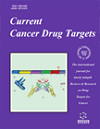- Home
- A-Z Publications
- Current Cancer Drug Targets
- Previous Issues
- Volume 13, Issue 3, 2013
Current Cancer Drug Targets - Volume 13, Issue 3, 2013
Volume 13, Issue 3, 2013
-
-
Diverse Mechanisms of AKT Pathway Activation in Human Malignancy
More LessAuthors: Mitchell Cheung and Joseph R. TestaAKT/PKB (Protein Kinase B) are central proteins mediating signals from receptor tyrosine kinases and phosphatidylinositol 3-kinase. AKT kinases are involved in a number of important cellular processes including cell proliferation and survival, cell size in response to nutrient availability, tumor invasion/metastasis, and angiogenesis. Various components of the AKT signaling pathway are encoded by tumor suppressor genes and Read More
-
-
-
Oxygen-independent Regulation of HIF-1: Novel Involvement of PI3K/ AKT/mTOR Pathway in Cancer
More LessAuthors: Faton Agani and Bing-Hua JiangStudies on erythropoietin regulation led to discovery of hypoxia-inducible factor 1 (HIF-1), a transcription factor which is central component of oxygen sensing mechanism in mammalian cells. The number of HIF-1 and hypoxiaregulated target genes has grown exponentially and includes genes that encode proteins with roles in erythropoiesis, angiogenesis, glycolytic pathway, glucose transport, metastasis, and cell survival Read More
-
-
-
Roles of EGFR, PI3K, AKT, and mTOR in Heavy Metal-Induced Cancer
More LessAuthors: Richard L. Carpenter and Bing-Hua JiangHumans are exposed to heavy metals through a variety of occupational and non-occupational means. Growing evidence has accumulated that prolonged exposure to these heavy metals is associated with cancer occurrence at various body sites including lung, liver, bladder, colon, and skin. Much research effort has been placed on discovering the mechanisms by which heavy metals induce different kinds of cancers. Results f Read More
-
-
-
Targeting the mTOR Pathway in Tumor Malignancy
More LessAuthors: Hengmiao Cheng, Marlena Walls, Sangita M. Baxi and Min-Jean YinThe mammalian target of rapamycin (mTOR) plays a critical role in the regulation of cell growth, proliferation, and metabolism by integrating growth factor stimulation and energy/nutrient input through a complex signaling network. The mTOR kinase is a part of two structurally and functionally distinct multiple protein complexes, mTORC1 and mTORC2. The mammalian target of rapamycin complex 1 (mTORC1) is ra Read More
-
-
-
IDO+ DCs and Signalling Pathways
More LessAuthors: Yue Wang, Bao-Hong Yang, Hui Li, Shui Cao, Xiu-Bao Ren and Jin-Pu YuDendritic cells (DCs) have traditionally been viewed as constituting an ‘information management’ system that functions solely to integrate a diverse array of incoming signals, in order to induce immune reactivity. In recent years, however, there has been a shift towards viewing these cells as key regulators in the orchestration of immunological tolerance, with increasing recognition that they are capable of suppressing T-cell respo Read More
-
-
-
Novel HSP90 Inhibitor NVP-AUY922 Enhances the Anti-tumor Effect of Temsirolimus Against Oral Squamous Cell Carcinoma
More LessBackground and Aim: Heat shock protein 90 (HSP90) and mammalian target of rapamycin (mTOR) are involved in the molecular pathogenesis of advanced oral squamous cell carcinoma. HSP90 inhibitors are capable of effectively interfering with multiple signaling pathways, including the mTOR signaling pathway. However, the combined effects of HSP90 and mTOR inhibitors on oral squamous cell carcinoma are still unkno Read More
-
-
-
Targeting Tyrosine Kinase Receptors in Hepatocellular Carcinoma
More LessThe recent discoveries of genomic and molecular markers in hepatocellular carcinoma (HCC) have improved the understanding about the complexity of the signal transduction pathways as well as their relevance in normal and liver cancer cells. The identification of the functional repercussions of punctual mutations and crosstalk among cell signaling will promote the identification of specific combinatorial targeted Read More
-
-
-
Novel Agents, Combinations and Sequences for the Treatment of Advanced Renal Cell Carcinoma: When is the Revolution Coming?
More LessAuthors: Matteo Santoni, Mimma Rizzo, Luciano Burattini, Rossana Berardi, Giacomo Carteni and Stefano CascinuBiological agents, such as multikinase inhibitors and mammalian target of rapamycin (mTOR) inhibitors, have replaced immunotherapy as the standard of care for metastatic renal cell carcinoma (mRCC). Several clinical trials have been performed, aimed to identify new feasible therapeutic targets. AKT, PI3K, STAT3, NOTCH-1, α5β1-integrin, CD70 and G250 are just examples of these opening frontiers. Novel agents, combina Read More
-
-
-
P-glycoprotein Inhibition as a Therapeutic Approach for Overcoming Multidrug Resistance in Cancer: Current Status and Future Perspectives
More LessAuthors: Ziyad Binkhathlan and Afsaneh LavasanifarOne of the major causes of failure in cancer chemotherapy is multidrug resistance (MDR), where cancer cells simultaneously become resistant to different anticancer drugs. Over-expression of membrane efflux pumps like Pglycoprotein (P-gp) that recognizes different chemotherapeutic agents and transports them out of the cell, plays a major role in MDR. The shortcoming of P-gp inhibitors in clinic has been attributed to their no Read More
-
Volumes & issues
-
Volume 25 (2025)
-
Volume 24 (2024)
-
Volume 23 (2023)
-
Volume 22 (2022)
-
Volume 21 (2021)
-
Volume 20 (2020)
-
Volume 19 (2019)
-
Volume 18 (2018)
-
Volume 17 (2017)
-
Volume 16 (2016)
-
Volume 15 (2015)
-
Volume 14 (2014)
-
Volume 13 (2013)
-
Volume 12 (2012)
-
Volume 11 (2011)
-
Volume 10 (2010)
-
Volume 9 (2009)
-
Volume 8 (2008)
-
Volume 7 (2007)
-
Volume 6 (2006)
-
Volume 5 (2005)
-
Volume 4 (2004)
-
Volume 3 (2003)
-
Volume 2 (2002)
-
Volume 1 (2001)
Most Read This Month
Article
content/journals/ccdt
Journal
10
5
false
en


